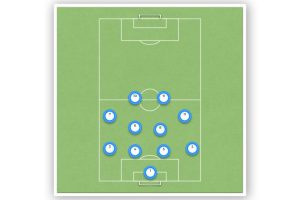What Is the Purpose of the Offside Rule in Soccer: A Comprehensive Explanation
The offside rule is one of the most important rules in soccer, and it is designed to regulate the movement of players on the field. It is a rule that has been in place for many years, and it is used to ensure that the game is played fairly and that there is no unfair advantage given to any team. The rule is designed to prevent players from being in an offside position when the ball is played to them by a teammate.
When a player is in an offside position, it means that they are closer to the opponent’s goal than both the ball and the second-to-last defender. This is important because it prevents players from camping out in front of the goal and waiting for the ball to come to them. The offside rule encourages more fluid play and ensures that the game is more exciting for both players and fans.
The Basics of the Offside Rule
The offside rule is one of the most important rules in soccer, and it can be a source of confusion for players and fans alike. At its core, the offside rule is designed to prevent players from camping out in front of the goal and waiting for a pass. By doing so, it encourages more fluid play and makes it more challenging for teams to score.
So, what exactly is the offside rule? Put simply, a player is offside if they are closer to the opponent’s goal than both the ball and the second-to-last defender when the ball is played to them. The second-to-last defender is usually the goalkeeper or a field player, and they must be between the player and the goal when the ball is played. If the player is beyond the second-to-last defender when the ball is played, they are offside.
It’s important to note that a player can only be called offside if they are involved in active play. This means that if they are not interfering with play or an opponent, they can be in an offside position without being penalized. Additionally, if the player receives the ball directly from a goal kick, throw-in, or corner kick, they cannot be offside.
| Player | Ball | Second-to-last Defender | Offside? |
|---|---|---|---|
| Player A | Pass | Goalkeeper | No |
| Player B | Pass | Defender | No |
| Player C | Pass | Defender | Yes |
The Purpose of the Offside Rule
The offside rule is one of the most important rules in soccer, and it has a significant impact on the way the game is played. The rule is designed to prevent players from standing near the opponent’s goal, waiting for a pass, and scoring an easy goal. The offside rule encourages teamwork, strategy, and fair play, and it has become an essential part of the game.
Preventing Goal Hanging
The primary purpose of the offside rule is to prevent goal hanging. In the early days of soccer, attackers would often stand near the opponent’s goal, waiting for a pass, and scoring an easy goal. This made the game boring and predictable, and it was not enjoyable to watch. The offside rule was introduced to force attackers to play a more active role in the game and to prevent them from scoring easy goals.
| Before Offside Rule | After Offside Rule |
|---|---|
| Attackers stand near the opponent’s goal, waiting for a pass. | Attackers have to move around the field, looking for opportunities to score. |
| Defenders have to stay near their own goal, preventing attackers from scoring. | Defenders can move up the field, creating more opportunities for their team to score. |
Encouraging Teamwork and Strategy
The offside rule also encourages teamwork and strategy. To avoid being caught offside, attackers have to time their runs and passes correctly, and they have to work together to create scoring opportunities. Defenders have to communicate effectively and work together to prevent attackers from scoring. The offside rule forces teams to play smarter and has resulted in some great tactical battles.
- Attackers have to time their runs and passes correctly.
- Attackers have to work together to create scoring opportunities.
- Defenders have to communicate effectively and work together to prevent attackers from scoring.
Promoting Fair Play and Sportsmanship
The offside rule also promotes fair play and sportsmanship. Without the offside rule, attackers would have an unfair advantage, and the game would be less fair. The rule ensures that both teams have an equal chance to score and win the game. Additionally, the offside rule encourages players to play within the rules and to respect their opponents.
| Benefits of Offside Rule |
|---|
| Promotes fair play and sportsmanship. |
| Ensures both teams have an equal chance to score and win the game. |
| Encourages players to play within the rules and to respect their opponents. |
Controversies Surrounding the Offside Rule
VAR and Offside Decisions
The introduction of Video Assistant Referee (VAR) technology has added a new layer of controversy to offside decisions in soccer. While the technology is meant to ensure greater accuracy in decisions, it has also led to confusion and frustration among players, coaches, and fans. One issue with VAR and offside decisions is the level of precision required to determine whether a player is offside. The technology allows officials to zoom in and analyze an offside decision to the millimeter, which can lead to marginal calls that are difficult to discern. This has led to criticism that VAR is ruining the game by taking away the human element and making decisions too technical.
Offside and Attacking Play
Another area of controversy surrounding the offside rule is its impact on attacking play. Some argue that the rule restricts attacking players from making runs behind the defense and limits the creativity of the game. Others argue that the rule encourages attacking players to time their runs more carefully and creates a more strategic game. One example of this controversy is the debate over whether the offside rule should be changed to allow attacking players to be onside if any part of their body is level with the last defender. This would give attackers more leeway to make runs behind the defense and create more scoring opportunities, but it would also make the game more difficult to officiate and could lead to more controversial decisions.
Offside and Defending Play
Finally, the offside rule has also been criticized for its impact on defending play. Some argue that the rule incentivizes defenders to play a more passive, defensive style by staying deep and not pushing up the field. Others argue that the rule encourages defenders to be more aggressive and press higher up the field to catch attackers offside. One example of this controversy is the debate over whether the offside rule should be changed to allow defenders to play an attacker onside if they are within a certain distance of the last defender. This would give defenders more flexibility to push up the field and create more exciting, attacking play, but it could also lead to more confusion and controversy over offside decisions. Overall, the controversies surrounding the offside rule reflect the complex and strategic nature of soccer. While the rule is meant to ensure fair play and encourage attacking creativity, it also creates challenges and controversies that must be carefully navigated by players, coaches, and officials alike.
Conclusion
The offside rule in soccer has been a crucial part of the game for over a century. Its purpose is to prevent players from gaining an unfair advantage by positioning themselves closer to the opponent’s goal than the ball and the second-last defender.
While the offside rule can be frustrating for attacking players and fans, it has led to more strategic gameplay and exciting tactical battles between teams. The rule has also helped to prevent teams from relying solely on long balls and quick counterattacks, encouraging more intricate passing plays and team coordination.
It is important for players, coaches, and fans alike to understand the offside rule and its nuances to fully appreciate the game of soccer. With a solid grasp of the rule, players can make smarter decisions on the field, coaches can develop effective game plans, and fans can better understand the flow and strategy of the game.
Overall, the offside rule serves to level the playing field and ensure that the game of soccer remains fair and competitive. Its importance cannot be overstated, and it will continue to be a fundamental aspect of the sport for years to come.







